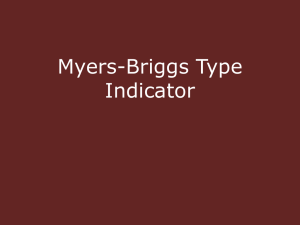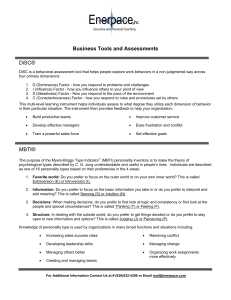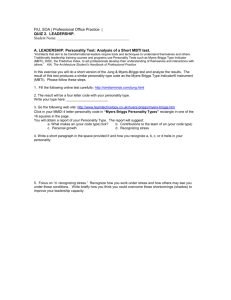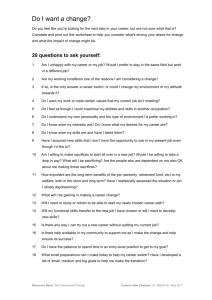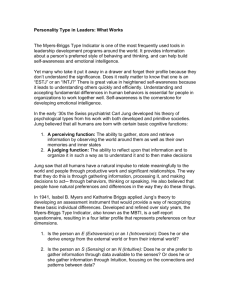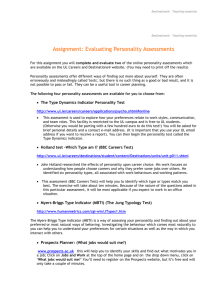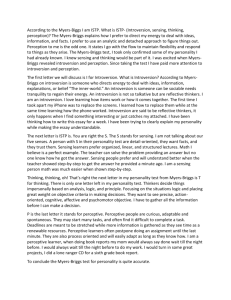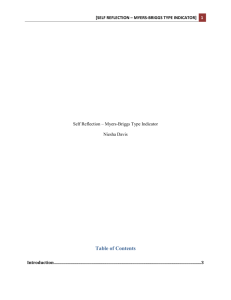Project Human Resource Management
advertisement
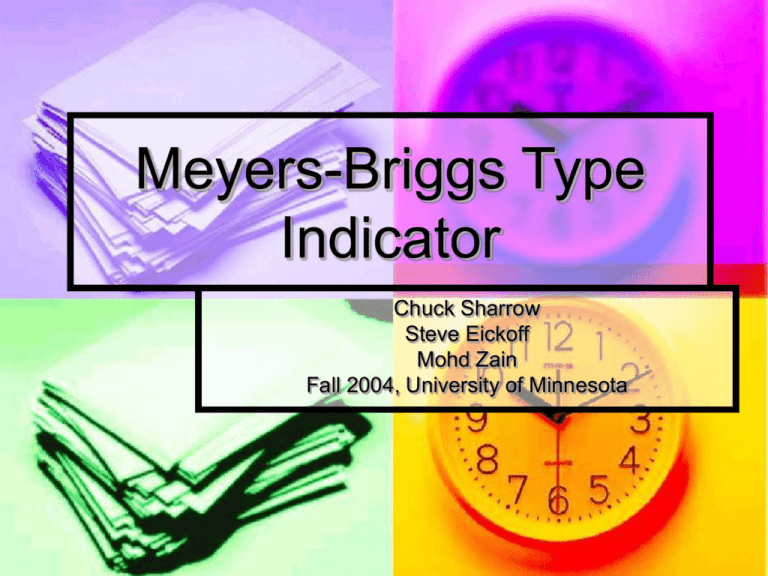
Meyers-Briggs Type Indicator Chuck Sharrow Steve Eickoff Mohd Zain Fall 2004, University of Minnesota What is the Myers-Briggs Type Indicator? Popular tool for determining personality preferences Very popular within industry and schools Used for team building, career guidance, leadership and management History of the MBTI Was developed by Katherine C Briggs and her daughter Isabel Myers Started in 1920’s and after a rigorous research, validity and reliability testing it was published in 1975 Translated into 16 languages and taken by over 2 million people per year Based on the work of Swiss psychologist Carl Jung who described personality type preferences Characteristics of MyersBriggs Type Indicator It's a self-report questionnaire, an indicator not a test, so there are no right or wrong answers Looks at normal behavior It identifies preferences rather than competencies, abilities or skills No personality type is better or worse - each has its own gifts The 4 scales of the MBTI Extroversion or Introversion Sensing or iNtuition Thinking or Feeling Judging or Perceiving Extroversion and Introversion People who prefer Extroversion… Focus their energy and attention outwardly Receive energy from interacting with people and from taking action Are energized by interacting with people Enjoy meeting and talking with new people Speak out easily and often at meetings Do their thinking as they speak Readily take initiative in work & relationships Extroversion and Introversion People who prefer Introversion… Focus their energy and attention inwardly Are interested in the world of thoughts and reflections Hold back at meetings and often have trouble getting involved Become drained and tired with people Need time to gather their thoughts before speaking Prefer to communicate in writing Take initiative when the situation or issue is very important to them Relationship to Management Neither type proven better suited for management Conflict resolution differences Reaction to issues Differences in focus Sensing and iNtuition People who prefer Sensing... Are practical and realistic Start at the beginning and take 1 step at a time Live in the present, dealing with the here and now Trust experience Like set procedures, established routines and historical precedents to guide them Work thoroughly step by step towards conclusions Sensing and iNtuition People who prefer iNtuition... Oriented to future possibilities Are imaginative and inventive Study the overall design to see how the parts fit Thrive on change, new ideas and variety Prefer imaginative new solutions to problems, often becoming impatient with details Move quickly to conclusions, follow hunches Relationship to Management Ss favor concrete and factual data, while Ns rely on hunches Preferences for information processing Predominance in top management Thinking and Feeling People who prefer Thinking… Make their decisions based on impersonal, objective logic Focus on the facts and principles Don’t take their emotions or those of others into account Are good at analyzing a situation and spotting flaws and inconsistencies Thinking and Feeling People who prefer Feeling… Make their decisions based on a person-centered, value-based process Focus on the personal values of people and organizations Are good at understanding people and their viewpoints Value and trust own feelings when making decisions Relationship to Management Decision making styles Types of management positions held Conflict management Judging and Perceiving People who prefer Judging… Like to live in a planned, orderly way Lives tend to be structured and organized Handle deadlines and time limits well Like getting to the bottom line quickly and deciding things quickly Judging and Perceiving People who prefer Perceiving… Want to explore all options before deciding Prefer to stay open to new information and last-minute options Adapt well to changing situations and like to respond resourcefully May have trouble making decisions Relationship to Management Career decisions Type of work environment Management style Personality Types Combined preferences indicate your personality type Each personality type lends itself to particular careers What type are you? Typical Careers ISTJ management accounting auditing efficiency expert engineer geologist bank examiners organization development electricians dentists pharmacist ISFJ counseling ministry library work nursing secretarial curators bookkeepers dental hygienists computer operator personnel administrator paralegal INFJ career counselor psychologist educational consultant artist editor/art director information-graphics designer merchandise planner environmental lawyer job analyst educational consultant architects INTJ management consultant economist scientist new business developer administrator mathematician psychologist biomedical researcher civil engineer editor/art director inventor Typical Careers ISTP surveyor fire fighter private investigator pilot police officer purchasing agent chiropractor medical technician securities analyst computer repair person ISFP bookkeeper clerical supervisor dental assistant physical therapist mechanic radiology technologist surveyor chef forester INFP information-graphics designer college professor researcher legal mediator social worker holistic health practitioner occupational therapist diversity manager human resource development specialist INTP strategic planning writer staff development lawyer architect software designer financial analyst college professor photographer logician Typical Careers ESTP ESFP real estate broker Chef land developer physical therapist stock broker news reporter fire fighter Promoter entrepreneur Veterinarian flight attendant floral designer real estate agent child care provider social worker Fundraiser athletic coach Musician Secretary ENFP conference planner speech pathologist HR development trainer Clergy Journalist Newscaster career counselor housing director character actor marketing consultant ENTP systems designer venture capitalist Actor Journalist investment broker real estate agent real estate developer strategic planner political manager Politician special projects developer Typical Careers ENFJ Entertainer Recruiter Artist Newscaster writer/journalist recreation director Librarian Facilitator Politician Psychologist housing director career counselor sales manager ESTJ government employee pharmaceutical sales Auditor computer analyst technical trainer project manager officer manager factory supervisor credit analyst electrical engineer stockbroker ENTJ program designer Attorney Administrator office manager chemical engineer sales manager logistics consultant franchise owner new business developer personnel manager investment banker ESFJ Nurse social worker Caterer flight attendant Bookkeeper medical/dental assistant exercise physiologist elementary school teacher minister/priest/rabbi retail owner Real World Applications N’s can benefit from the natural inclination of S’s to… Bring up pertinent facts Face realities of current situation Apply experience to solving problems Focus on what needs attention now S’s can benefit from the natural inclination of N’s to… Bring up new possibilities Anticipate future trends Apply insight to solving problems Focus on long-term goals Real World Applications F’s can benefit from the natural inclination of T’s to… Analyze situations and their implications Hold consistently to a policy Create rational systems Be fair T’s can benefit from the natural inclination of F’s to… Forecast how others will react and feel Make needed individual exceptions Organize people and tasks harmoniously Be just Skeptical views of the Myers-Briggs Type Indicator Unscientific A Temptation to Pigeonhole It emphasizes each person being one specific type rather than each person using a certain type of thinking most of the time. Real people do not fit easily into one of sixteen types because they use different styles of thinking at different times Benefits of MBTI PM’s can benefit from knowing team members’ MBTI Profiles Adjust management style for each individual Get variety of personality types on project Resources Gardner, William: “Using the Myers-Briggs Type Indicator to study managers”, Journal of Management http://www.findarticles.com/p/articles/mi_m4256/is_n1_v22/ai_18345344 Connecting Personality Types With Careers and Jobs http://www.doi.gov/octc/typescar.html Bast, Mary: PROBLEM SOLVING--With the MyersBriggs Type Indicator (MBTI) http://www.breakoutofthebox.com/mbti.htm BrainyEncyclopedia: Myers-Briggs Type Indicator http://www.brainyencyclopedia.com/encyclopedia/m/my/myers_briggs_type_indi cator.html
